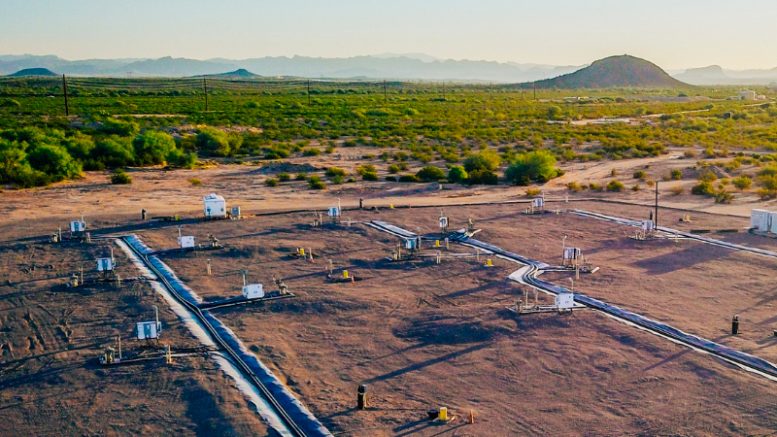Taseko Mines (TSX: TKO; NYSE-AM: TGB; LSE: TKO) says operating its Florence Copper production test facility in Arizona over the past 18 months has increased its confidence in the in situ recovery (ISR) project, and it’s ready to begin construction as soon as its permits come through.
The Vancouver, B.C.-based base metals miner released updated economics for the project after hours yesterday in a new technical report. The new figures show an after-tax net present value (NPV) using an 8% discount of US$930 million and an after-tax internal rate of return (IRR) of 47%. Payback is expected relatively quickly at 2.6 years. The company’s previous 2017 technical report put Florence Copper’s after-tax NPV (8%) at US$680 million at a copper price of $3 per lb., and its IRR at 37%.
Overall, the operation is forecast to produce 85 million lb. of metal yearly over a 22-year mine life.
Taseko is still waiting for the U.S. Environmental Protection Agency to issue an underground injection control permit. At least one analyst suggests the permit could come as early as July, after which the remainder of the US$232 million capital spend to develop Florence over 18 months from the completed test stage to a commercial scale can get underway.
Taseko had in January secured US$25 million in additional financing to pay for the solvent extraction and electrowinning (SX/EW) plant with Bank of America Leasing & Capital, and follows an initial investment of US$50 million made recently by Japan’s Mitsui for construction of the project.
Taseko’s president and CEO, Stuart McDonald, said in a statement that despite the high inflation the industry has recently endured, Florence economics stands out as one of the world’s lowest capital intensity copper development projects.
“With procurement of long-lead items well advanced, we are ready to commence construction of the commercial facility following the issuance of the final UIC permit in the coming months,” McDonald said.
Inflation has marginally increased projected operating cost from US$1.10 per lb. previously to US$1.11 per lb.
BMO Capital Markets mining analyst Rene Cartier points out Taseko has made efforts to curb the effects of inflation by ordering long-lead items well in advance.
“Taseko indicated the primary driver of cost increases related to construction labour and wellfield drilling costs, which impact both initial and sustaining capital costs. Sustaining capital was a bit higher than our estimates,” the analyst said in a note.
“We still see the operating cost profile of Florence as competitive, which could provide Taseko additional optionality, if required. For instance, we estimate an additional 2% net smelter return royalty on the project would only add about US$0.07 per lb. to costs,” the analyst said.
“Overall, TKO has de-risked the project, and was able to incorporate learnings from the test work that’s been undertaken, thereby leading to a higher degree of confidence at Florence.”
Copper recovery
The Florence ISR process works by injecting a weak sulphuric acid solution, called raffinate, through targeted portions of the mineral deposit using an array of injection wells. The raffinate passes through natural fractures and voids in the deposit, dissolving the copper mineralization.
The copper-laden solution, known as pregnant leach solution, is then collected in recovery wells, and pumped to the surface for processing. The copper is extracted from the pregnant solution using solvent extraction and electrowinning techniques producing a copper cathode product.
Leaching of the production test wellfield began in December 2018. It continued under commercial operating conditions until June 2020, after the leaching phase was ramped down and concluded with the shutdown of the process plant that October.
The test well field was then transitioned into a rinsing phase, which is still in progress, Taseko said.
Taseko says the test demonstrated that copper could be produced profitably and that the hydraulic control of process solutions in the well field could be established and maintained to protect underground drinking water aquafers.
Florence Copper has proven and probable reserves of 320 million tons grading 0.36% copper for 2.3 billion lb. of contained metal, using a US$3.05 per lb. copper price.
At $2.26, Teseko shares are down 19% over the 12 months, having tested $1.15 and $3. The company has a market capitalization of $663.9 million.


Be the first to comment on "Taseko beefs up economics for Florence ISR copper project as it waits for permit"